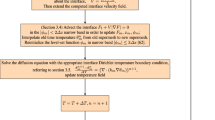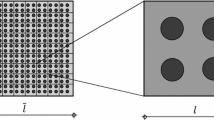Abstract
In this paper, a multi-scale analysis scheme for solidification based on two-scale computational homogenization is discussed. Solidification problems involve evolution of surfaces coupled with flux jump boundary conditions across interfaces. We provide consistent macro-micro transition and averaging rules based on Hill’s macro- homogeneity condition. The overall macro-scale behavior is analyzed with solidification at the micro-scale modeled using an enthalpy formulation. The method is versatile in the sense that two different models can be employed at the macro- and micro-scales. The micro-scale model can incorporate all the physics associated with solidification including moving interfaces and flux discontinuities, while the macro-scale model needs to only model thermal conduction using continuous (homogenized) fields. The convergence behavior of the tightly coupled macro-micro finite element scheme with respect to decreasing element size is analyzed by comparing with a known analytical solution of the Stefan problem.
Similar content being viewed by others
References
Hashin Z (1983) Analysis of composite materials. J Appl Mech 50: 481–505
Rosen BW, Hashin Z (1970) Effective thermal expansion coefficients and specific heats of composite materials. Int J Eng Sci 8: 157–173
Noor AK, Shah RS (1993) Effective thermoelastic and thermal properties of unidirectional fiber-reinforced composites and their sensitivity coefficients. Comput Struct 26: 7–23
Auriault JL (1983) Effective macroscopic description of heat conduction in periodic composites. Int J Heat Mass Transf 26(6): 861–869
Boutin C (1995) Microstructural influence on heat conduction. Int J Heat Mass Transf 38(17): 3181–3195
Guedes JM, Kikuchi N (1990) Preprocessing and postprocessing for materials based on the homogenization method with adaptive finite element methods. Comput Methods Appl Mech Eng 83: 143–198
Jiang M, Jasiuk I, Ostoja-Starzewski M (2002) Apparent thermal conductivity of periodic two-dimensional composites. Comput Mater Sci 25: 329–338
Ostoja-Starzewski M, Schulte J (1996) Bounding of effective thermal conductivities of multiscale materials by essential and natural boundary conditions. Phys Rev B 54(1): 278–285
Sigmund O, Torquato S (1997) Design of materials with extreme thermal expansion using a three-phase topology optimization. J Mech Phys Solids 45: 1037–1067
Wang CY, Beckermann C (1995) Equiaxed dendritic solidification with convection: part I. Multiscale/Multiphase modeling. Metallurgical Mater Trans A 25: 2754–2764
Eck C, Knabner P, Korotov S (2002) A two-scale method for the computation of solid-liquid phase transitions with dendritic microstructure. J Comput Phys 178: 58–80
Lee PD, Chirazi A, Atwood RC, Wang W (2004) Multiscale modelling of solidification microstructures, including microsegregation and microporosity, in an Al-Si-Cu alloy. Mater Sci Eng A 365: 57–65
Tan L, Zabaras N (2007) Multiscale modeling of alloy solidification using a database approach. J Comput Phys 227: 728–754
Rafii-Tabar H, Chirazi A (2002) Multiscale computational modelling of solidification phenomena. Phys Rep 365: 145–249
Gravemeier V, Lenz S, Wall WA (2008) Towards a taxonomy for multiscale methods in computational mechanics: building blocks of existing methods. Comput Mech 41: 279–291
Smit RJM, Brekelmans WAM, Meijer HEH (1998) Prediction of the mechanical behaviour of nonlinear heterogeneous systems by multi-level finite element modeling. Comput Methods Appl Mech Eng 155: 181–192
Miehe C, Schroeder J, Schotte J (1999) Computational homogenization analysis in finite plasticity. Simulation of texture development in polycrystalline materials. Comput Methods Appl Mech Eng 171: 387–418
Kouznetsova VG, Brekelmans WAM, Baaijens FPT (2001) An approach to micromacro modeling of heterogeneous materials. Comput Mech 27: 37–48
Sundararaghavan V, Zabaras N (2006) Design of microstructure-sensitive properties in elasto-viscoplastic polycrystals using multi-scale homogenization. Int J Plast 22: 1799–1824
Ozdemir I, Brekelmans WAM, Geers MGD (2008) FE 2 computational homogenization for the thermo-mechanical analysis of heterogeneous solids. Comput Methods Appl Mech Eng 198(3–4): 602–613
Ozdemir I, Brekelmans WAM, Geers MGD (2008) Computational homogenization for heat conduction in heterogeneous solids. Int J Numer Meth Eng 73: 185–204
Ostoja-Starzewski M (2002) Towards stochastic continuum thermodynamics. J Non Equilib Thermodyn 27: 335–348
Miehe C (1996) Numerical computation of algorithmic (consistent) tangent moduli in large-strain computational inelasticity. Comput Meth Appl Mech Eng 134(3–4): 223–240
Balay S, Buschelman K, Eijkhout V, Gropp WD, Kaushik D, Knepley MG, McInnes LC, Smith BF, Zhang H (2004) PETSc users manual ANL-95/11—revision 2.1.5. Argonne National Laboratory
Rubenstein LI (1971) The Stefan problem. Trans Math Monographs. American Mathematical Society (AMS), Providence, p 27
Crank J (1984) Free and moving bounday problems. Clarendon Press, Oxford
Shyy W, Udayhumar HS, Rao MM, Smith RW (2007) Computational fluid dynamics with moving boundaries, 1st edn. Dover, Mineola
Author information
Authors and Affiliations
Corresponding author
Rights and permissions
About this article
Cite this article
Lee, S., Sundararaghavan, V. Multi-scale homogenization of moving interface problems with flux jumps: application to solidification. Comput Mech 44, 297–307 (2009). https://doi.org/10.1007/s00466-009-0371-x
Received:
Accepted:
Published:
Issue Date:
DOI: https://doi.org/10.1007/s00466-009-0371-x




